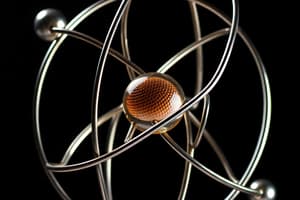Podcast
Questions and Answers
What was the primary hypothesis tested by Rutherford's gold foil experiment?
What was the primary hypothesis tested by Rutherford's gold foil experiment?
- Atoms consist solely of electrons.
- Atoms are indivisible.
- Atoms contain a dense nucleus. (correct)
- Atoms have equal numbers of protons and electrons.
Thomson's model proposed that protons and electrons are uniformly mixed throughout the atom.
Thomson's model proposed that protons and electrons are uniformly mixed throughout the atom.
True (A)
What did Rutherford conclude about the density of the atom based on his experiments?
What did Rutherford conclude about the density of the atom based on his experiments?
The atom is mostly empty space.
The nucleus contains a positive charge and most of the ______ of the atom.
The nucleus contains a positive charge and most of the ______ of the atom.
Match the following models of the atom with their main proponents:
Match the following models of the atom with their main proponents:
Which of the following statements is true regarding the findings of the gold foil experiment?
Which of the following statements is true regarding the findings of the gold foil experiment?
According to Rutherford's model, the nucleus is larger than the entire atom.
According to Rutherford's model, the nucleus is larger than the entire atom.
What particles were primarily targeted in Rutherford's gold foil experiment?
What particles were primarily targeted in Rutherford's gold foil experiment?
What was a key limitation of Rutherford's model of the atom?
What was a key limitation of Rutherford's model of the atom?
Bohr’s model of the atom states that electrons can exist in any energy state.
Bohr’s model of the atom states that electrons can exist in any energy state.
What change occurs when an atom transitions from a high-energy state to a lower energy state?
What change occurs when an atom transitions from a high-energy state to a lower energy state?
According to Bohr's model, the angular momentum of the electron is quantized in integral multiples of _____.
According to Bohr's model, the angular momentum of the electron is quantized in integral multiples of _____.
Which postulate of Bohr's model is entirely incorrect?
Which postulate of Bohr's model is entirely incorrect?
Match the following models with their respective features:
Match the following models with their respective features:
The _____ force between the electron and nucleus must be balanced by the centrifugal force for mechanical stability in the Bohr model.
The _____ force between the electron and nucleus must be balanced by the centrifugal force for mechanical stability in the Bohr model.
What happens to an electron when it is in a stationary state according to Bohr’s model?
What happens to an electron when it is in a stationary state according to Bohr’s model?
Flashcards
Thomson's model of atom
Thomson's model of atom
Protons and electrons are uniformly mixed throughout the atom.
Rutherford's gold foil experiment
Rutherford's gold foil experiment
Experiment to test Thomson's model using alpha particles and gold foil.
Alpha particles
Alpha particles
Positively charged particles used in Rutherford's experiment.
Atom's empty space
Atom's empty space
Signup and view all the flashcards
Atomic nucleus
Atomic nucleus
Signup and view all the flashcards
Rutherford's model conclusion
Rutherford's model conclusion
Signup and view all the flashcards
Subatomic particles
Subatomic particles
Signup and view all the flashcards
Gold foil
Gold foil
Signup and view all the flashcards
Rutherford's atomic model flaws
Rutherford's atomic model flaws
Signup and view all the flashcards
Nuclear atom instability
Nuclear atom instability
Signup and view all the flashcards
Bohr's atomic model
Bohr's atomic model
Signup and view all the flashcards
Electron radiation (Bohr)
Electron radiation (Bohr)
Signup and view all the flashcards
Allowed electron motion (Bohr)
Allowed electron motion (Bohr)
Signup and view all the flashcards
Bohr model postulate accuracy
Bohr model postulate accuracy
Signup and view all the flashcards
Balance of forces in Bohr model
Balance of forces in Bohr model
Signup and view all the flashcards
Modern Quantum theory
Modern Quantum theory
Signup and view all the flashcards
Study Notes
General Chemistry I - Lecture 1: Models of Atom
- Lecture delivered by Dr. Mahmoud A. A. Ibrahim, Chemistry Department, Faculty of Science, Minia University
- Lecture number 1 covers atomic models
- Models of the atom include Thomson's, Rutherford's, and Bohr's models
Thomson's Model
- Developed in 1911, after the components of the atom (protons and electrons) were discovered
- Proposed a model where protons and electrons are mixed uniformly throughout the atom
Rutherford's Model
- Rutherford tested Thomson's hypothesis with the gold foil experiment
- Bombardment of a gold foil with alpha particles (Helium nuclei)
- Observations:
- Most alpha particles passed straight through the foil
- Some alpha particles were deflected slightly
- Very few alpha particles were deflected greatly
- Even fewer bounced off the foil and back
- Conclusions:
- The atom is mostly empty space
- The nucleus is small, dense, and positively charged
- The nucleus contains most of the atom's mass, and is 100,000 times smaller than the atom
Rutherford's Model Difficulty
- The model failed to explain the stability of atoms and atomic spectra from the classical viewpoint
Bohr's Model
- Developed two years after Rutherford's model
- Proposed that electrons are in stationary states of motion with fixed energies
- Electrons do not radiate when in these stationary states
- When an electron changes energy levels, it emits or absorbs a quantum of radiation, equal to the difference in energy between the levels
- Electrons orbit the nucleus in circular orbits
- Angular momentum of electrons is an integral multiple of h/2π
- Bohr's postulates, while initially accepted, are partly or entirely incorrect by modern quantum theory standards
Bohr's Model Derivation of Energy States
- The derivation of energy state expressions is straightforward
- Mechanical stability requires balancing Coulombic and centrifugal forces
- Coulombic force = Centrifugal force = (Ze2)/(4πε0r2) = mv2/r
Studying That Suits You
Use AI to generate personalized quizzes and flashcards to suit your learning preferences.




